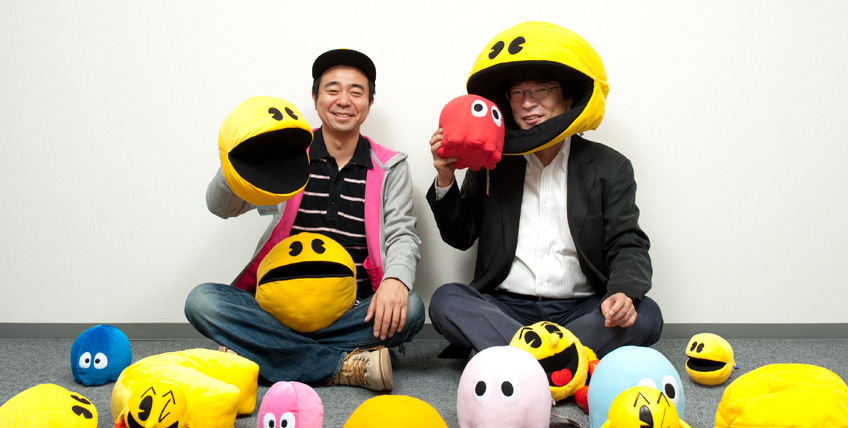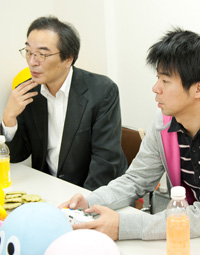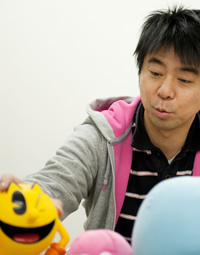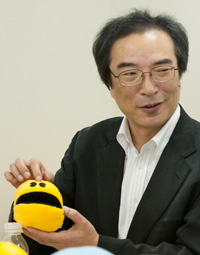2/12/2010

Before the interview, we had Arino-san play the original PAC-MAN (Arino-san left, Iwatani-san right).
We wanted to create a cute game
"It's been several decades since I last played" said Arino-san. But, as a skilled and experienced gamer, he proceeded through the game as expected.
While Arino-san was playing, he started asking Iwatani-san some questions about PAC-MAN, including some that he's been wondering about for a long time.

Interviewer: The PAC-MAN character is cuter than other characters from games released before PAC-MAN.
Iwatani: Yes. Actually, PAC-MAN is the first cute game. Before PAC-MAN was released, most games were aggressive, where you did things like shoot aliens. At the time when PAC-MAN was released, the image of the game arcade was that it was a dark and scary place, and it's a place for only guys. However, we knew that there would be no future in arcades unless girls and couples would come in as well. So PAC-MAN was planned around the concept of "Let's have girls in game arcades." That's also why the enemy characters were colorful – they would be harder to hate.
Interviewer: I see. So, did a lot of girls come into game arcades then?
Iwatani: Yes. We went to the arcade after the game was released and saw a lot of excited girls and couples playing the game. That was what we expected.
(Lots of products based on PAC-MAN were also produced. The Interviewer looks at the stuffed PAC-MAN toys and continues his questions.)
Interviewer: When PAC-MAN was released, there were no character goods like this, were there?
Iwatani: No, there were not. However, we knew from the beginning that we wanted to expand the PAC-MAN business to merchandising the brand out for character goods. I sewed stuffed toys by myself during the planning phase for PAC-MAN and made t-shirts with iron ons.
Interviewer: You sewed them yourself! But the actual final products didn't come out until long after you did this development work, right?
Iwatani: Yes, it was after the game became a huge hit in the U.S., after the original Japan release. Subsequently, many goods based on PAC-MAN were released, including ties, phones, and golf balls.
Interviewer: PAC-MAN became a cartoon in the US, right?
Iwatani: Yes, and at one point it had a viewer rating as high as 56%. If a kid was around 7 years old when watching the PAC-MAN cartoon, he or she would now in their mid-30s. Their kids are now around the same age, so fathers can now tell their kids that they used to watch the PAC-MAN cartoon and play with the PAC-MAN game with their kids. It will be nice if PAC-MAN can continue from generation to generation like this.
Interviewer: Sounds nice.
Iwatani: In fact, PAC-MAN was the first game to produce video game related character goods. The original Japan upright cabinet had a PAC-MAN with hands and legs illustrated on its side panels. In addition to being the first with character goods, this was also the first time a video game used a character as a part of cabinet design.
Interviewer: I see. It started from the illustration. However, the illustration might be hidden often as upright arcade cabinets are placed next to each other.
Iwatani: That's right. But, you can see the
illustration if it's placed at the end. 
About PAC-MAN's color

Interviewer: PAC-MAN has always been yellow. Why was yellow chosen?
Iwatani: We thought that yellow was peaceful color. It's a "neutral color" which neither represents friend or foe.
Interviewer: I see. The form was from a pizza, right? I always thought that the yellow came from the yellow cheese on a pizza.
Iwatani: Yes, I guess you could imagine it as "pizza cheese yellow".
Interviewer: In many video games, the character's color changes to pink or green or some other color when the game affects a change. Is there no such thing with PAC-MAN?
Iwatani: No. Since the game already has 4 different colorful Ghosts, we used only yellow for the main character. This concept would be kind of difficult in future games when the concept of several PAC-MANs showing up on one screen at the same time. There was a game called "PAC-MAN VS." where several people could play at the same time. When it was created, I was told to change the PAC-MAN colors to differentiate from each other. However, I said no.
Interviewer: But what would you do if you are creating such a game? Use flags or different colors of light yellow?
Iwatani: Flags wouldn't look good, and light yellow would make it even more difficult to see the difference.
Interviewer: What then, maybe tails?
Iwatani: That might be a good idea.  We've often come up with ideas and concepts around
cooperative multiplayer gaming. Whenever that idea comes up, we
discussed how to differentiate your game character from others. However,
the discussion always ends up with no other color being appropriate
except yellow. Maybe in the future, with the technology progresses,
there would by eye glasses with filters that enable you to see your PAC-MAN only.
We've often come up with ideas and concepts around
cooperative multiplayer gaming. Whenever that idea comes up, we
discussed how to differentiate your game character from others. However,
the discussion always ends up with no other color being appropriate
except yellow. Maybe in the future, with the technology progresses,
there would by eye glasses with filters that enable you to see your PAC-MAN only.
Interviewer: Wow, I didn't realize how important it was to you to avoid other colors except for yellow; that you would demand that technology progress before you change the color. That shows how much passion you have to keeping true to PAC-MAN.
Iwatani: Yes, I definitely would like to keep PAC-MAN yellow. 
The name of the game

Interviewer: Why is the game named PAC-MAN?
Iwatani: It was from eating sound, as often seen in cartoons, "Paku Paku."
("Paku" is the Japanese sound for "Chomp")
Interviewer: Were there any other options?
Iwatani: "Pakkuri" or several other options were come up. We had meetings on this, but the name was finalized as "Puckman" pretty quickly.
Interviewer: Are other games" names determined so smoothly as well?
Iwatani: Racing games, such as "Ridge Racer" or "Pole Position" were named without any trouble. Same as "XEVIOUS." Each person involved gave his or her ideas on the name but right after someone said "XEVIOUS", we all knew it was the name.
Interviewer: It was determined unanimously?
Iwatani: Yes. The word "XEVIOUS" just rolled right off our tongues.
Interviewer: At what point in development did you start working on finalizing a name for a game? Is it after the completion of the characters?
Interviewer: The character names are typically determined around the time that the game is 70-80% complete. For the game name however, we have to make printed materials so the name needs to be finalized a little earlier. Normally, game names are determined around 50% completion mark.
Interviewer: I see. The game title has to be determined around the time that the overall concept of the game is completed.
Iwatani: Here's another story about PAC-MAN's name. Originally, the spelling of PAC-MAN was "PUCKMAN" in Japan. However, it was not accepted for use in the US.
Interviewer: Why?
Iwatani: If a part of the "P" is chipped off a little bit, it will be an "F."
Interviewer: And people would chip it deliberately?
Iwatani: That's right. "PAC" was suggested as an alternate while discussing this issue with the Americans. So the name then became "PAC-MAN." The game was subsequently re-imported to Japan, and so even in Japan the title is written as "PAC-MAN"
Interviewer: Is the game popular internationally among women?
Iwatani: Yes. Regardless of age or sex, this character is accepted by everyone. The game is easy to play as the control stick has only 4 directions. This game is widely popular as it's known not only in North America but in Europe, Asia and even a small island in the center of the Pacific Ocean.
Interviewer: And if there are new games featuring PAC-MAN, the characters and game rules stay pretty much true to the original. Even if it changes it still stays the same.
Iwatani: That's right. Meaning that the original PAC-MAN is the standard that we follow.
Profile
Toru IWATANI
DOB: Jan 25, 1955 Born in Tokyo, Game Creator.
Known as a father of PAC-MAN. He also developed Gee Bee which was the first video game title for Namco and designed the game "Bomb Bee," the sequel of Gee Bee. Additionally, he designed the graphics of "QTQ" and worked on the titles "Dragon Buster," "Genpeitoumaden," "Ridge Racer," and "Alpine Racer." He served as the producer for "Time Crisis." Currently, Iwatani-san is a professor at Tokyo Polytechnic University, a board member in the Digital Game Association, and a Namco Bandai Games fellow.








